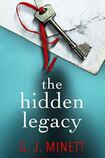
The past is a foreign country for Ellen Sutherland, the protagonist of Graham Minett's debut novel, The Hidden Legacy. Ellen is a 40-something, recently divorced mother-of-two who has long since given up trying to piece together her history.
As a teenager, Ellen begged her closed-off mother, Barbara, for information about her father but never learnt his identity. Barbara suffers from dementia and has lived in a nursing home for the past 12 years. At best, Ellen hopes in her visits for that “half-smile, hinting at recognition”.
With two children to look after, as well as managing a holiday park in Chichester, Ellen has little time to dwell on the past and an arrival of a letter from a solicitor is initially viewed as an intrusion into her busy life. But this is no ordinary letter: Ellen has been left a cottage in Cheltenham to the value of three-quarters of a million pounds by a woman she has never heard of. Eudora Nash's titular bequest becomes the starting point of a journey not just into the West Country but also into Ellen's unknown heritage.
In this thriller Minett uses multiple narrators and devices to tell the tale. The letter, emails, phonecalls, newspaper articles, hidden documents on computers and voicemails all divulge plot and give readers snippets of the story.
A gripping prologue set in the 1960s is told through the voice of a 12-year-old child, John Michael Adams, a victim of bullying at school who takes a horrific revenge on two female pupils. The schoolyard atmosphere is vivid and intense: “They’re wiggling their little fingers and chanting ‘half inch’ in high, squeaky voices, clouds of warm breath clinging to them like speech bubbles in a cartoon.”
Sensationalism
In revenge, John Michael sets his bullies on fire, leaving one girl dead and the other severely maimed. “Every Parent’s Nightmare” is how the press brand him as the trial gets underway. Clippings from local newspapers show sensationalism, bias and unethical journalism, one of many issues that the book seeks to highlight. The media’s role in turning a tragedy into a circus is poignantly summed up in a later section by Josef, the father of the girl who dies: “Every Parent’s Nightmare, they used to call him, as if desperate to claim a share of the agony and loss for themselves.”
What spurred John Michael to such a drastic action is hinted at but withheld until the novel’s later segments. A further mystery surrounds his new identity when he gets released from prison years later, and what has happened to his father, Martin, who also went to ground because of media hounding.
The book’s rather unartful structure lets the reader know early on that Ellen’s new cottage is linked to the tragedy. The narrative shifts in a plodding fashion from the 1960s storyline to 2008 Cheltenham, where Ellen is trying to piece it all together with her best friend, Kate. There are visits along the way to the 1970s and also to 2001, with the reader conveniently meeting characters at various important junctures.
The multiple narrators include Ellen; John Michael; John Michael’s father; an amoral journalist; Ellen’s mother, Barbara; a bereaved father, Josef; and the mysterious dead woman, Eudora Nash, who leaves two documents on a laptop for Ellen to read. Naturally, Eudora is a freelance journalist and book reviewer who happens to have a flair for writing. Her voice is more authorial than character driven, though the sequence of events that she lays out is intriguing. Cliff-hangers are used to keep the reader guessing, with the book shifting away from Eudora’s narrative to other voices after key revelations.
Most readers should work out the mystery elements about half-way through the story, which is not to say that the book is a failure. Minett has created a cast of interesting characters and there is satisfaction in watching them discover the untruths and half-truths handed down through generations. Serious issues – child abuse, bullying, trial by media, violence, divorce, the bond between parent and child – are sensitively explored.
Minett, who studied at Cambridge and has an MA in creative writing from the University of Chichester, is skilled at character sketching and description. A sleazy journalist is “like one of those sticky burrs you pick up on your clothes when you walk through woods”. Ellen is the type of woman who wants “to turn every shirt collar of a sentence inside out, looking for labels”. A wintry West Country landscape is similarly vivid: “The darkened skies were full of [snow]\, not isolated flurries but a thick swathe of fat flakes which settled in clusters on her outstretched sleeve.”
As Ellen sifts through the past, she learns that things were indeed done differently there. Glints of a more hopeful future are tempered with reality in the book’s closing scenes. Running away from your past might work for a while, but hidden legacies will out eventually. Sarah Gilmartin is an arts journalist












